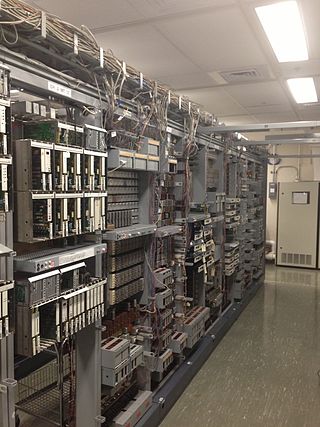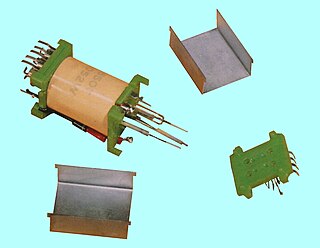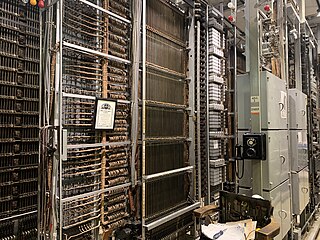
A telephone switchboard is a device used to connect circuits of telephones to establish telephone calls between users or other switchboards. The switchboard is an essential component of a manual telephone exchange, and is operated by switchboard operators who use electrical cords or switches to establish the connections.
Direct distance dialing (DDD) is a telecommunications service feature in North America by which a caller may, without operator assistance, call any other user outside the local calling area. Direct dialing by subscribers typically requires extra digits to be dialed as prefixes to the directory telephone number of the destination. International Direct Distance Dialing (IDDD) extends the system beyond the geographic boundaries of the North American Numbering Plan (NANP).
In telephony, ringdown is a method of signaling an operator in which telephone ringing current is sent over the line to operate a lamp or cause the operation of a self-locking relay known as a drop.

In electronics and telecommunications, a crossbar switch is a collection of switches arranged in a matrix configuration. A crossbar switch has multiple input and output lines that form a crossed pattern of interconnecting lines between which a connection may be established by closing a switch located at each intersection, the elements of the matrix. Originally, a crossbar switch consisted literally of crossing metal bars that provided the input and output paths. Later implementations achieved the same switching topology in solid-state electronics. The crossbar switch is one of the principal telephone exchange architectures, together with a rotary switch, memory switch, and a crossover switch.
A dial tone is a telephony signal sent by a telephone exchange or private branch exchange (PBX) to a terminating device, such as a telephone, when an off-hook condition is detected. It indicates that the exchange is working and is ready to initiate a telephone call. The tone stops when the first dialed digit is recognized. If no digits are forthcoming, the partial dial procedure is invoked, often eliciting a special information tone and an intercept message, followed by the off-hook tone, requiring the caller to hang up and redial.

A blue box is an electronic device that produces tones used to generate the in-band signaling tones formerly used within the North American long-distance telephone network to send line status and called number information over voice circuits. During that period, charges associated with long-distance calling were commonplace and could be significant, depending on the time, duration and destination of the call. A blue box device allowed for circumventing these charges by enabling an illicit user, referred to as a "phreaker," to place long-distance calls, without using the network's user facilities, that would be billed to another number or dismissed entirely by the telecom company's billing system as an incomplete call. A number of similar "color boxes" were also created to control other aspects of the phone network.

A telephone call or telephone conversation, also known as a phone call or voice call, is a connection over a telephone network between the called party and the calling party. Telephone calls started in the late 19th century, initially relying on analog systems. As technology advanced, the majority of telephone calls moved from traditional landlines to cellular networks and mobile phones. Telephone calls have also become common over the internet, using Voice over IP (VoIP) technology. They are typically used for real-time conversation between two or more parties, especially when the parties cannot meet in person.

On analog telephone lines with special services, a flash or register-recall signal is used to control functions on the public telephone exchange, PBX or VoIP ATA.
An intercept message is a telephone recording informing the caller that the call cannot be completed, for any of a number of reasons ranging from local congestion, to disconnection of the destination phone, number dial errors or network trouble along the route.
The off-hook tone is a telephony signal for alerting a user that the telephone has been left off-hook without use for an extended period, effectively disabling the telephone line.
In telephony, ground start is a method of signaling from a terminal of a subscriber local loop to a telephone exchange, where one side of a cable pair is temporarily grounded to request dial tone. Most middle 20th-century American payphones used coin-first ground start lines, with the starting ground connection provided by the coin itself, bridging a set of contacts as it passed through the coin chute.
In telecommunication, supervision is the monitoring of a telecommunication circuit for telephony to convey to an operator, user, or a switching system, information about the operational state of the circuit. The typical operational states of trunks and lines are the idle and busy states, seizure, and disconnect. The states are indicated by various electrical signals and electrical conditions depending on the type of circuit, the type of terminating equipment, and the type of intended service.
The Number Five Crossbar Switching System is a telephone switch for telephone exchanges designed by Bell Labs and manufactured by Western Electric starting in 1947. It was used in the Bell System principally as a Class 5 telephone switch in the public switched telephone network (PSTN) until the early 1990s, when it was replaced with electronic switching systems. Variants were used as combined Class 4 and Class 5 systems in rural areas, and as a TWX switch.
The Number One Crossbar Switching System (1XB), was the primary technology for urban telephone exchanges served by the Bell System in the mid-20th century. Its switch fabric used the electromechanical crossbar switch to implement the topology of the panel switching system of the 1920s. The first No. 1 Crossbar was installed in the PResident-2 central office at Troy Avenue in Brooklyn, New York which became operational in February 1938.

The Number One Electronic Switching System (1ESS) was the first large-scale stored program control (SPC) telephone exchange or electronic switching system in the Bell System. It was manufactured by Western Electric and first placed into service in Succasunna, New Jersey, in May 1965. The switching fabric was composed of a reed relay matrix controlled by wire spring relays which in turn were controlled by a central processing unit (CPU).

TXE, was a family of telephone exchanges developed by the British General Post Office (GPO), designed to replace the ageing Strowger switches.
A junctor is a circuit used in analog telephone exchanges, including the Number One Crossbar Switching System, Number Five Crossbar Switching System, 1ESS switch and other switches.
Ringing is a telecommunication signal that causes a bell or other device to alert a telephone subscriber to an incoming telephone call. Historically, this entailed sending a high-voltage alternating current over the telephone line to a customer station which contained an electromagnetic bell. It is therefore also commonly referred to as power ringing, to distinguish it from another signal, audible ringing, or ringing tone, which is sent to the originating caller to indicate that the destination telephone is in fact ringing.

A telephone exchange, also known as a telephone switch or central office, is a crucial component in the public switched telephone network (PSTN) or large enterprise telecommunications systems. It facilitates the interconnection of telephone subscriber lines or digital system virtual circuits, enabling telephone calls between subscribers.

The Panel Machine Switching System is a type of automatic telephone exchange for urban service that was used in the Bell System in the United States for seven decades. The first semi-mechanical types of this design were installed in 1915 in Newark, New Jersey, and the last were retired in the same city in 1983.







